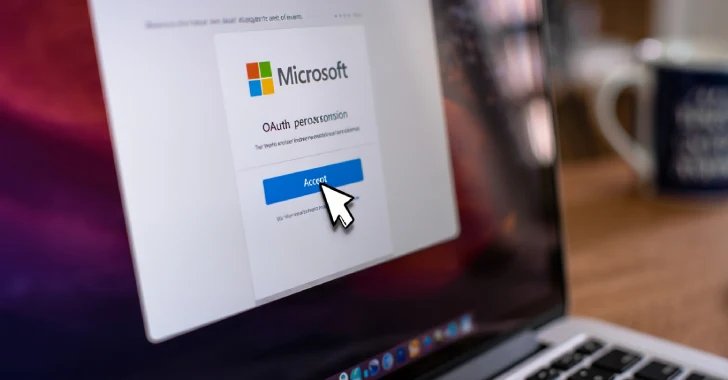Cybersecurity researchers element a cluster of latest actions during which risk actors are impersonating pretend Microsoft OAuth purposes as companies to advertise qualification harvests as a part of an account acquisition assault.
“Faux Microsoft 365 purposes are spoofing quite a lot of firms, together with RingCentral, SharePoint, Adobe, Docusign, and extra,” ProofPoint stated in a report Thursday.
The continued marketing campaign, first detected in early 2025, is designed to make use of OAuth purposes as gateways and makes use of phishing kits akin to Tycoon and ODX that may implement multi-factor authentication (MFA) phishing to achieve unauthorized entry to customers’ Microsoft 365 accounts.
The Enterprise Safety Firm stated the strategy utilized in e mail campaigns with over 50 spoofing purposes has been noticed.
The assault begins with a phishing e mail despatched from a compromised account and goals to trick the recipient into clicking on the URL underneath the pretext of sharing a request for a quote (RFQ) or enterprise contract settlement.
Whenever you click on on these hyperlinks, the sufferer is directed to the Microsoft OAuth web page of an utility named “Ilsmart” that asks you to view the essential profile and grant permission to take care of ongoing entry to information that’s granted.
What’s noteworthy about this assault is the shopping for and promoting of ILSMART, a reliable on-line market for the aviation, marine and protection industries.
“Utility permissions present restricted use for attackers, however are used to set the following stage of an assault,” ProofPoint stated.
Whether or not the goal accepts or rejects the requested permissions, you’ll first be redirected to the CAPTCHA web page, after which as soon as the verification is full, you can be redirected to the Microsoft Account Verification web page.
This pretend Microsoft web page makes use of intermediate (AITM) phishing expertise powered by the most recent phishing (PHAAS) platform to reap sufferer {qualifications} and MFA codes.
Similar to final month, ProofPoint stated it had detected one other marketing campaign the place emails have been despatched through e mail advertising and marketing platform Twilio Sendgrid, and impersonating Adobe, designed with the identical objective in thoughts.
The marketing campaign represents a drop in buckets in comparison with general big-name exercise, with a number of clusters leveraging toolkits to run account takeover assaults. In 2025 alone, makes an attempt to compromise accounts have been noticed affecting almost 3,000 person accounts throughout greater than 900 Microsoft 365 environments.
“Menace actors are creating more and more revolutionary assault chains in an try and bypass detection and achieve entry to organizations worldwide,” the corporate stated, including, “We anticipate risk actors to focus on person identities and AITM credential phishing to change into the crime trade normal.”
As of final month, Microsoft introduced plans to enhance safety to replace default settings by blocking legacy authentication protocols and requesting administrator consent for third-party app entry. The replace is anticipated to be accomplished by August 2025.
“This replace may have a optimistic impression on the panorama general and can hamstring risk actors utilizing this system,” ProofPoint famous.
This disclosure follows Microsoft’s resolution to disable exterior workbook hyperlinks by default between October 2025 and July 2026 to reinforce the safety of workbooks.
The findings are used to deploy a few of the .NET malware referred to as VIP keyloggers, which might use spear phishing emails meant as cost receipts, and use car-based injectors to steal delicate information from compromised hosts, Seqrite stated.
Within the months, it was found that spam campaigns conceal set up hyperlinks to distant desktop software program in PDF information to bypass e mail and malware safety. The marketing campaign is believed to be primarily focused at organizations in France, Luxembourg, Belgium and Germany since November 2024.
“These PDFs are sometimes disguised to appear like invoices, contracts, or property lists to extend reliability and appeal to victims and click on on built-in hyperlinks,” Safe stated. “The design was meant to create an phantasm of obscure, authorized content material, and inspired the sufferer to put in this system. On this case, this system was Fleetdeck RMM.”
Different Distant Monitoring and Administration (RMM) instruments deployed as a part of the exercise cluster embody Action1, Optitune, Bluetrait, Syncro, Superops, Atera, and ScreenConnect.
“Whereas no post-infection payload has been noticed, the usage of RMM instruments strongly suggests its position as an preliminary entry vector and will enable for much more malicious exercise,” the Finnish firm added. “Ransomware operators specifically help this strategy.”









